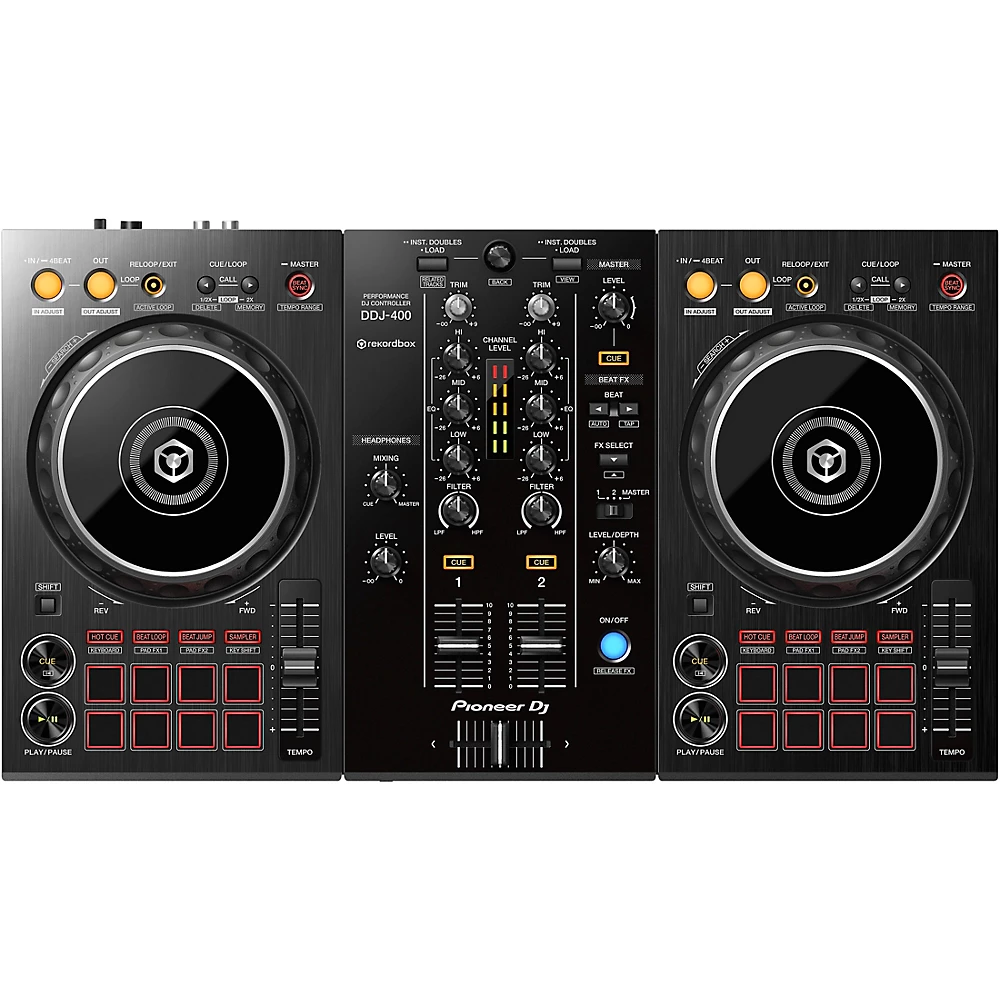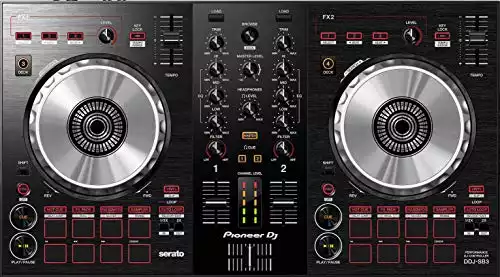While both of these Pioneer DJ controllers are great, only one can be the top dog.
In the world of DJing, Pioneer DJ is one of the more well-known producers of DJ equipment. In particular, they are known for producing high-quality entry-level DJ controllers that virtually anyone can pick up and start playing with.
Along with precious few alternatives, you can’t get much better than what Pioneer DJ has to offer.
Of course, just because they are known for putting together impressive starter controllers doesn’t mean that all Pioneer DJ controllers are created equal.
DDJ-400 Vs DDJ-SB3: Overview
Which one is best for you?
While there will be gaps in quality based on the differing price points, even controllers at comparable value can have something of a hierarchy.
Two controllers that probably exemplify this the most clearly are Pioneer DJ’s two beginner-level controllers, the DDJ-400 and the DDJ-SB3.
Both controllers have been around a while, coming onto the scene in 2018, and aren’t too far apart when it comes to their respective price tags.
In this overview, we’ll be diving into both of these DJ controllers and their features to see which of the two is objectively the better option.
Though there will likely be a bit of subjectivity that sprouts up, we’ll try to keep this clear on what they do that’s good and what they may be lacking before seeing which is ultimately the best bet for someone looking to get started in the DJ space.
Pioneer DJ DDJ-400 Explained
The Pioneer DJ DDJ-400, like the SB3, is an entry-level controller built and designed for starter DJs to seriously have something to play with before graduating to more advanced and fleshed-out DJ options (higher-end controllers, CDJs, or turntables).
The controller has a fairly standard size, stretching out 18.98 inches in end-to-end width. The DDJ-400 is also 2.3 inches in depth while having a height of 10.72 inches.
The controller comes with two separate channels each carrying its corresponding turntable platter as well as all of the expected additional ports, such as a headphone (mini-jack), microphone (1/4 inch TS Jack), and a Master RCA area.
The controller comes with Rekordbox already included, making it a great buy for anyone that wants to get started right away without having to worry about what controller software to use.

Read this next: DDJ SB3: Still a Game Changer?
Things We Liked:
- Club DJ Layout
- Includes Rekordbox DJ Software
- More Modern FX Options
- Fully Established Performance Pad
Club DJ Layout
The DDJ-400’s most immediately noticeable feature is its layout and design.
Built to emulate what you’d expect in a club setting or more along the lines of a professional performance DJ’s layout, the DDJ-400 is certainly meant to appeal to those interested in taking their DJing journey seriously from a professional performance perspective.
The controller shares many similarities with CDJs or higher-end controllers, like the DDJ-1000, if either was marked down a bit in price and features.
Comes With Rekordbox DJ Software
Unlike the SB3, the DDJ-400 comes with DJ software, rekordbox DJ is already included. While there are many similarities between the two options, rekordbox is generally regarded as having a cleaner user interface while also being a bit easier to use for beginners.
Not only that, but Rekordbox also has more features included in its free option.
You won’t get every single thing, no, but compared to competing DJ software types on the market (Serato being the most infamous), you can pretty much get started without spending any more money.
More Modern FX Options
The DDJ-400 prides itself on being more along the lines of modern professional club DJ controllers. This is seen in many areas of the controller’s layout, the most pressing being in the FX options.
Here, the controller replaces FX sections with a Beat FX strip that sits next to the mixer in the middle of the unit.
This helps beginner DJs get used to playing with the Beat FX feature before moving onto a DJM or CDJ setup, both of which also use Beat FX rather than the old-school FX sections.
Fully Established Performance Pad
In the case of the performance pad, the DDJ-400 relies entirely on it for the different features.
As a result, you have all the expected performance options available, from Beat Jump and Hot Cue, to Beat Loop, Keyboard, Pad FX1 & 2, as well as Beat Loop and Key Shift.
Outside of that, the controller also uses a Loop In, Loop Out, as well as a Reloop button.
You can also Cue tracks as well as perform Loop Calls, all of which make looping more accessible for those that plan to eventually transition to the more expensive and professional CDJs later on.
Things We Do Not Like:
- Not As Versatile
- Does Not Have Pad Scratch
- Only Comes With Two-Channels
Not Quite As Versatile
One challenge with the DDJ-400 is that, for all its progression towards newer and more modern features, it leaves behind a few things that were simply done better with older models.
For example, the controller no longer has things like Auto Loop (for toggling a loop on or off) nor does it have the more accessible FX sections that are normally seen with more traditional controllers. These sections often are easier to play with and offer a bit of a greater variety in how you perform.
Does Not Have Pad Scratch
A big loss for the DDJ-400 is its lack of the Pad Scratch feature. This is a pretty awesome FX-related feature that essentially lets you perform pre-programmed scratches.
We’ll go more in-depth on this with the SB3, but suffice it to say that, while the DDJ-400 tries to overcome this deficiency with the different performance pad features, the controller is most certainly not the ideal choice for anyone looking to perform any type of scratching.
Only Has Two Channels
Probably the biggest drawback with the DDJ-400 is how limited it is in terms of its available channels.
The controller only contains the standard two-channel setup, and while this normally would be a problem, the fact that there isn’t any method of extending that out hurts its long-term appeal, particularly for people that want to include multiple sounds.
Ultimately, the controller is not meant for outrageous performances, and its lack of options to extend its channel usage shows that.
This product is now discontinued. Only used and second-hand units are available via the relevant marketplaces.
- Professional looping section included
- Incredibly good build quality
- Reasonable pricing and good portability
- Responsive performance pad section
- Looping section is complex
- Plastic throughout
Verdict
The DDJ-400 is a compelling controller with a lot of fun things going for it.
By fitting itself more in line with professional DJ controllers and CDJs, users can more easily put themselves in the right headspace before transitioning to something more on the higher end.
Even on its own, the DDJ-400 is impressive, with accurate manual tempo matching and a longer pitch fader, making fading in and out of a track pretty easy.
All in all, if you’re serious about being a professional DJ and performing in clubs and party events (think Ibiza!), the DDJ-400 is right for you.
Not only is it a great DJ controller in and of itself, but it perfectly sets you up to perform on more impressive DJ devices later on.
Pioneer DJ DDJ-SB3 Explained
The Pioneer DJ DDJ-SB3, while having a fair bit of difference in terms of its features, does have several things that are also pretty similar to the DDJ-400. In particular, both controllers are fairly comparable to one another in terms of overall size and weight.
The SB3 is around 19 inches in width while its depth is just over 2.3 inches and its height is 10.7 inches.
When you consider how the DDJ-400 stacks up, from a dimension standpoint, the two controllers could be nearly identical.
Outside of the dimensions and some of the various external ports, however, the two controllers couldn’t be more different.
Here, the SB3 uses the Serato DJ software while its overall layout is intentionally designed to be more traditional than the DDJ-400’s more modern CDJ setup.

Read this next: DDJ 400: Perfect for Beginner DJs?
Things We Like:
- Uses Serato DJ Software
- More Extensive Layout
- Includes Additional Decks
- Varied Performance Pad Features
Uses Serato DJ Software
Certainly a great option for those that are veterans, the SB3 uses the Serato DJ software. While there are pros and cons to both it and Rekordbox, Serato has been around longer and has a more exhaustive list of features by comparison.
The software is also currently still the most popular option and is what most professionals still use to this day.
Of course, if you aren’t interested in Serato, the SB3 is also compatible with the Virtual DJ 8 software.
This gives SB3 DJs more variety and options on what they want compared to DDJ-400 users.
More Extensive Layout
The SB3 layout is meant to be reminiscent of the more traditional DJ controllers and turntable options.
While this does lead to things being less streamlined, it also offers a lot more features and variety for DJs. As an example, the SB3 includes features like Auto Loop and FX sections.
Auto-loop allows DJs to turn a loop on or off as well as halve or double its length.
The FX sections, on the other hand, allow DJs to affect the different parameters while also affecting the amount of FX that is applied.
Includes Additional Decks
A big factor to consider is that the SB3 offers DJs numerous channels to play with outside of the standard two.
The controller offers a total of four different decks that a DJ can access, selecting between them with the ‘Deck Select’ buttons.
This is great for instances where a DJ may plan to include other variables into their performance outside of the two standard decks.
It’s only for Serato DJ Pro, but that’s still better than anything the DDJ-400 offers.
Varied Performance Pad Features
When it comes to the different performance pad features, many of the functions are shared between both controllers.
One of the big departures, however, is the inclusion of the Pad Scratch feature. This lets DJs perform different scratches that were pre-programmed by other DJs.
There are eight total tracks available, all ranging from fairly simple to expert-level.
These tracks are in-built, meaning you can use them without needing to download anything or handle an update.
Things We Do Not Like:
- Limited Growth
- Less Free Features w/ Serato
- Less Streamlined
Limited Growth
While there are a lot of great things about the SB3, the reality is that it isn’t going to make a serious resurgence in the professional field or setting.
Certainly, its layout is great for hobby or old-school traditional setups, however, it’s also an antiquated layout that more people are moving away from.
Less Free Features w/ Serato
The big challenge when it comes to the Serato DJ software is that it always has a bit of fine print at the end. In particular, it’s the fact that many of its main features are “soft-locked” behind the Pro version as opposed to the Lite version.
This means that you’ll need to invest in additional funds just to get all of the promised features that come with the area; something that isn’t nearly as restrictive with rekordbox.
Less Streamlined
Ultimately, the SB3, while having a ton of different features, isn’t that well streamlined like the DDJ-400.
This essentially means that it’s going to take a lot more time to understand everything that the SB3 can do compared to the DDJ-400 and its more simplified list of features.
- Helps with learning how to scratch
- Lightweight design
- Plug and play
- Amazing value
- Bit too simplistic
- Only comes with Serato Lite
Verdict
There’s no arguing that the DDJ-SB3 has a lot going for it.
The challenge comes when you want to jump into using a CDJ or want to take things more seriously from a professional setting.
In either instance, it may be a bit of a challenge to transition into what most club DJs and CDJ setups are like.
If, however, you have no problem enjoying what the SB3 has to offer with its old-school setup, there are still plenty of things about it that make it the best choice to pick of the two.
Which Is Best?
The first thing to realize is that both options truly are awesome for starting DJs. However, if you have to pick one, it does strongly depend on what you want to do.
The DDJ-400 is the more streamlined of the two options, making it great for people that want to eventually transition to CDJs or a more professional setup later on.
On the other hand, the SB3 is more varied with more options to play with provided you aren’t looking to switch over to anything else later on.
Ultimately, despite both options being incredible, I’d have to say that the DDJ-400 is the better option of the two.
While it doesn’t offer as many features, much of this is because they have been made more streamlined and easier to understand.
Not only that, but the fact that it eventually can result in you easily transitioning to CDJs or controllers in a professional setting gives it that extra edge and is something every beginning DJ should seriously consider looking into.
DDJ-400 Vs DDJ-SB3: Summary
Both controllers offer a lot of value and are worth serious consideration based on your goals and what you want in a controller.
By understanding the strengths and weaknesses of either controller, you can also determine what type of DJ you want to be.






